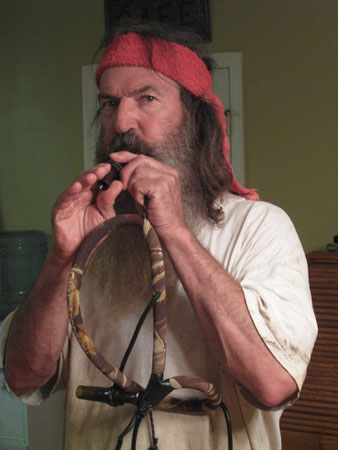 Joe: Is there a best call material — wood, plastic, acrylic — all around?
Joe: Is there a best call material — wood, plastic, acrylic — all around?
Phil: Wood gives you a mellow sound. For the most part, synthetic materials give you longevity. But you can mix a lot of materials in plastic and make it "wood-like."
Joe: Did the engineering aspect interest you when you first began building duck calls?
Phil: Very much so. Most of our plastic calls came from wooden calls that we made mistakes on. When we had a wood one that was really unique and sounding great, we would duplicate it.
Joe: What is the single biggest mistake you see novice callers make?
They call too much.
Most people think if you call a lot, somehow that's going to help you. I would say right off the bat, he overdoes it. It's either too much or too loud or at the wrong time or all three together. When we see ducks coming, we don't do anything. If they think the decoys are ducks, we let them come right in.
Joe: Does a $150 call kill more ducks than a $20 call?
Phil: No.
I've said the only way I'd pay $150 for a duck call was if after I'd called ducks and killed them with it, I could turn the call around and it would somehow suck the feathers off the ducks. Then I'd pay $150 for it. Anything less than that, it just ain't worth it. My wife says I'm the world's worst salesman. But some people create a market for them.
Joe: What is the best call Duck Commander call ever built? Not your favorite, but the best?
Phil: As far as like a duck, one of the duckiest we ever built ... I know this because we were contacted by a man that worked in the voice analysis department of the FBI … he said, in his spare time he put mallard ducks in his machine and compared them to a bunch of duck calls. He said, "You are the winner, my man." The call he was referring to was our Cut-Down Reacher. So according to the FBI, the call is a duck. We don’t even sell it anymore. It was too hard to blow. People didn't want to take the time to learn how to use it.
Joe: Everybody thinks the Duckmen are phenomenal shotgunners. What makes you guys such good shots?
Phil: It's a number of things. You might as well be the one to write it down.
One: the days of hunting for the fun of it are long gone. Everything is filmed. Cameramen are set up in deer stands, holes in the ground, inner tubes. They trust us that we won't shoot them. They say there are times when ducks come in and they're thinking, "Oh, my goodness …" (they're going to be shot). We need the ducks where the cameramen can film them. We condition ourselves to know when (the ducks) are in the window of opportunity for the camera. And that window is just point-blank 20, 15, 10 yards — right there. The reason they look like they just powder is because they are just right in our face. But with a video camera, it looks like they're quite (farther). That's one.
Second, you've got six guys in a bunker, and we are loaded to the gills. The two best gunners are on each side.
Joe: Who's that?
Phil: That's Jase and me. Everybody else is just in the middle. You're basically just using them for ... well, you know. It's a critical call on who calls (the shot) because this thing is about timing. Think about it. Ducks will be past everybody and on their way outside the hole in (one second). Therefore, that first call is a critical one. Nobody does it perfect. The shooting starts before they even get there. I want the ducks to rise up. They're rising up and going out and away, but as they're going, everybody's got (a good shot). You're drawing more firepower at the optimum distance. The call is critical.
On one of the videos, 15 teal come in, and we killed them all. A guy said it was trick photography. I said, "Did it look like they were dying? It looked like that 'cause that's what was happening.”
Also, we tend to shoot tighter chokes than most people because we want to see them powdered, because we've got gun people and shell people that want to sell shotguns and shells.
Joe: What guns and shells do you shoot?
Phil: We shoot 3-inch (number) threes, Black Cloud shells, and Benelli shotguns.
Joe: You can shoot whatever shell you want, especially within Federal's brand. Do you think Black Clouds make that big of a difference, personally?
Phil: I really do.
We shoot full chokes, mostly. If we're going to shoot teal, we use improved cylinders. You don't need a full-choke gun unless you want to see them disintegrate …
Si (his brother Silas), he's got an open bore and his glasses are (real thick). So he's got just a spray gun, but it's good to have one man with a spray gun…
Joe: Any special sights? Anything to that?
Phil: Nothing to that.
Joe: When is the last time you went duck hunting and nobody shot a duck?
Phil: (Long pause)
Joe: You can say "I don't remember."
Phil: I can't remember.
>> Part 3 of Phil's interview is coming soon. Check out Part 1 if you haven't already CLICK HERE.






